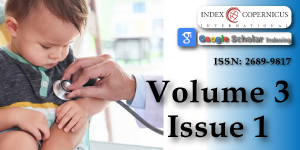Child neglect - still a neglected problem in the global world: A review
Main Article Content
Abstract
Child neglect is a global problem that involves large costs for both the individual and for society. This article is based on published reviews and meta-analyses in the field of child neglect between 1980 and 2018. Of a total of 433 articles, 13 was included, main Data bases has been PubMed, Scopus, Web of Science, Psych Info, ERIC, CINAHL. The prevalence in the normal population was found to be between 16% and 26%, while the prevalence in clinical groups seem to be significantly higher. For example, was the prevalence of neglect 50% among patients with eating disorder. It is especially important to know who is reporting neglect. Research shows that neglect is strongly associated with among other things, depression, one of the most common illnesses among the general public. The theoretical models that are used are ecological. Risk factors can be found at all levels when using ecological models. Research shows that factors involving the relationship parent-child are among the most important. Neglect is more common in low-income countries than in high income countries.
Most studies point to the importance of prevention. Existing preventive programs are most often of family and parental character.
More research is needed, especially as concerns the development of preventive programs that can identify specific types of neglect and present suitable preventive measures, both at the societal and family level.
Article Details
Copyright (c) 2020 Tingberg B, et al.

This work is licensed under a Creative Commons Attribution 4.0 International License.
Erickson M, Egeland B. Child neglect. In: Myers J, Berliner L, Briere,J, Hendiz C, Jenny C, Reid T, editors. The APSAC handbook on child maltreatment. 2nd Ed. Sage Publications; Thousand Oaks. 2002.
Dubowitz H, Bennett S. Physical abuse and neglect of children. Lancet. 2007; 369: 1891-1899. PubMed: https://pubmed.ncbi.nlm.nih.gov/17544770/
Maguire S, Naughton A. Neglect: widespread, damaging and difficult to identify. Paediatrics and Child Health (UK). 2016; 26: 485-487.
Woodman J, Lecky F, Hodes D, Pitt M, Taylor B, et al. Screening injured children for physical abuse or neglect in emergency departments: a systematic review. Child Care Health Dev. 2009; 36; 2: 153-164. PubMed: https://pubmed.ncbi.nlm.nih.gov/20047596/
Prevoo MJL, StoltenborghM, Alink LRA, Bakermans‐Kranenburg MJ, van IJzendoorn MH. Methodological Moderators in Prevalence Studies on Child Maltreatment: Review of a Series of Meta-Analyses. Child Abuse Review. 2017; 26: 141-157.
Mulder TM, Kuiper KC, van der Put CE, Stams GJM, Assink M. Risk factors for child neglect: A meta-analytic review. Child Abuse Negl. 2018; 77: 198-210. PubMed: https://pubmed.ncbi.nlm.nih.gov/29358122/
Knight L, Collins K. A 25-year retrospective review of deaths due to pediatric neglect. The American journal of forensic medicine and pathology. 2005; 26: 221-228. PubMed: https://pubmed.ncbi.nlm.nih.gov/16121076/
Kvist T, Cocozza M, Annerbäck EM, Dahllöf G. Child maltreatment - prevalence and characteristics of mandatory reports from dental professionals to the Social Services. Int J Paediatr Dent. 2016; 27:3-10. PubMed: https://pubmed.ncbi.nlm.nih.gov/26992159/
Naidoo S. A Profile of the Oro-Facial Injuries in Child Physical Abuse at a Children's Hospital. Child Abuse Negl. 2000; 24: 521-534. PubMed: https://pubmed.ncbi.nlm.nih.gov/10798841/
Butchard A, Phinney Harvey A, Mian M, Fürniss T. Preventing Child Maltreatment: A guide to taking action and generating evidence. World Health Organization, Geneva, 2006 Geneva/Aurora, CO: WHO. 2006.
Shea BJ, Grimshaw JM, Wells GA, Boers M, Andersson N, et al. Development of AMSTAR: a measurement tool to assess the methodological quality of systematic reviews. BMC Med Res Methodol. 2007; 7: 10. PubMed: https://pubmed.ncbi.nlm.nih.gov/17302989/
World Health Organization. Report of the Consultation on Child Abuse Prevention 29-21 March 1999, WHO, Geneva. World Health Organization: Geneva. 1999.
Fang X, Fry DA, Brown DS, Mercy JA, Dunne MP, et al. The burden of child maltreatment in the East Asia and Pacific region. Child Abuse and Neglect. 2015; 42: 146-162. PubMed: https://pubmed.ncbi.nlm.nih.gov/25757367/
Fang X, Fry DA, Finkelhor D, Chen J, Lannen P, et al. The burden of child maltreatment in China: a systematic review. Bull World Health Organ. 2015; 93: 176-185c. PubMed: https://pubmed.ncbi.nlm.nih.gov/25838613/
Fu H, Feng T, Qin J, Wanf T, Wu X, et al. Reported prevalence of childhood maltreatment among Chinese college students: A systematic review and meta-analysis. PLoS One. 2018; 13: e0205808. PubMed: https://pubmed.ncbi.nlm.nih.gov/30321243/
World Health Organization. World Health Report 2005: Make every mother and child count. Geneva: WHO, 2005
Stoltenborgh M, Bakermans-Kranenburg MJ, van Ijzendoorn MH, Alink LR. Cultural-geographical differences in the occurrence of child physical abuse? A meta-analysis of global prevalence. Int J Psychol. 2013; 48: 81–94. PubMed: https://pubmed.ncbi.nlm.nih.gov/23597008/
Moore SE, Scott JG, Ferrari AJ, Mills R, Dunne MP, et al. Burden attributable to child maltreatment in Australia. Child Abuse Negl. 2015; 48: 208-220. PubMed: https://pubmed.ncbi.nlm.nih.gov/26056058/
Maguire SA, Williams B, Naughton A, Cowley L, Tempest V, et al. A systematic review of the emotional, behavioural and cognitive features exhibited by school-aged children experiencing neglect or emotional abuseChild Care Health Dev. 2015; 41: 641-653. PubMed: https://pubmed.ncbi.nlm.nih.gov/25733080/
Nelson J, Klumparndt A, Doebler P, Ehring T. Childhood maltreatment and characteristics of adult depression: Meta-analysis. Br J Psychiatry. 2017; 210: 96-104. https://pubmed.ncbi.nlm.nih.gov/27908895/
Norman RE, Byambaa M, De R, Butchart A, Scott J, et al. The Long-term health consequences of child Physical abuse, emotional abuse, and neglect: A systematic reiview and meta-analysis. Plos Med. 2012; 9: 11e1001349. PubMed: https://pubmed.ncbi.nlm.nih.gov/23209385/
Viola TW, Salun GA, Kluwe-Schiavon B, Sanvicente-Viera B, Levandowski ML, et al. The influence of geographical and economic factors in estimates of childhood abuse and neglect using the Childhood Trauma Questionnaire: A worldwide meta-regression analysis. Child Abuse Negl. 2016; 51: 1-11. PubMed: https://pubmed.ncbi.nlm.nih.gov/26704298/
Lane W, Sacco P, Downton K, Ludeman E, Levy L, et al. Child maltreatment and problem gambling: A systematic review. Child Abuse Negl. 2016; 58: 24-38. PubMed: https://pubmed.ncbi.nlm.nih.gov/27337693
Pignatelli AM, Wampers M, Loriedo C, Biondi M, Vanderlinden J. Childhood neglect in eating disorders: A systematic review and meta-analysis. J Trauma Dissociation. 2017; 18: 100-115. PubMed: https://pubmed.ncbi.nlm.nih.gov/27282982/
Stith MS, Liu T, Davies C, Boykin EL, Adler MC, et al. Risk factors in child maltreatment: A meta-analytic review of the literature. Aggression and Violent, Behavior. 2009; 14: 13-29.

